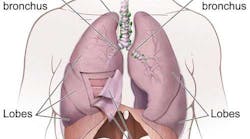Source: National Cancer Institute So what does this have to do with us, as oral health care professionals? A beautiful smile not only looks great, but may also decrease the risk of developing certain cancers. A Japanese study reported that tooth loss was associated with greater risk of lung, esophageal, and head and neck cancers.(6)
Treatment for lung cancer with two intravenous bisphosphonates can cause both short- and long-term side effects. Short-term side effects that may occur immediately after receiving these drugs are flu-like symptoms such as fever, chills, and muscle aches. These side effects are often mild, do not last long, and tend not to recur following future bisphosphonate treatments.
The long-term side effects have been reported in some cancer patients treated with these intravenous bisphosphonates include osteonecrosis (ONJ). ONJ is literally “dead bone” of the jaw, and is a rare dental condition. It is an area of exposed jaw bone that shows no sign of healing after eight weeks. The condition can cause feelings of pain or numbness in the affected area.
As most cases of osteonecrosis of the jaw have occurred in patients treated with intravenous bisphosphonate drugs – mainly pamidronate (Aredia) and zoledronic acid (Zometa) – there is concern, but no proof, that ONJ is a side effect of these medications. Osteonecrosis of the jaw is much more likely to occur after an invasive dental procedure, such as an extraction.
Lung cancer patients should have a careful examination before starting therapy with pamidronate or zoledronic acid, and follow good oral health procedures.(9) Additional information can be found in the Bone and Cancer Foundation publication “Osteonecrosis of the Jaw – Information for Cancer Patients”.(10)
Maria Perno Goldie, RDH, MS
To read previous RDH eVillage FOCUS articles by Maria Perno Goldie, go to articles.










